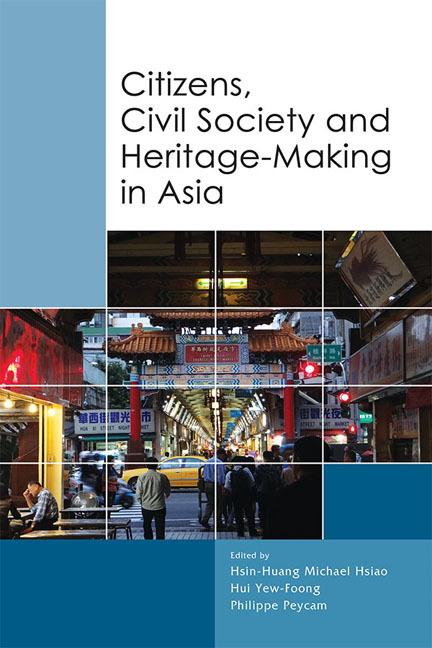Book contents
- Frontmatter
- Contents
- Contributors
- 1 Introduction: Finding the Grain of Heritage Politics
- 2 Heritage, Identity and Power
- 3 Heritage-Making and Post-coloniality in Yangon, Myanmar
- 4 Living Heritage of Ruins? Contesting the Paradox in Trowulan's Majapahit Heritage
- 5 The Reconstruction of Heritage in Rural Vietnam: An Analysis of State and Local Dynamics
- 6 Performing Cultures, Negotiating Identities: The Cultural Politics of Indigenous Cultural Villages in West Malaysia
- 7 Constituting Philippine Filmic and Linguistic Heritage: The Case of Filipino Regional Films
- 8 Encounter and Counter-Narratives of Heritage in Macau
- 9 Cultural Activities of the Chinese Community in Post-war Myanmar
- 10 Chinese Street Opera in Singapore: Heritage or a Vanishing Trade
- 11 Policy Formation and Civil Society Engagement in Heritage-Making in Taiwan: A Historical Examination
- 12 Becoming Taiwanese: Appropriation of Japanese Colonial Sites and Structures in Cultural Heritage-Making — A Case Study on the Wushantou Reservoir and Hatta Yoichi
- 13 Defining Culture in the Heritage Preservation of Taiwanese Veterans’ Villages: The Case of Zuoying
- 14 Tobacco Crop Memories in Taiwan: The Heritage of a Deadly Agriculture
- Index
12 - Becoming Taiwanese: Appropriation of Japanese Colonial Sites and Structures in Cultural Heritage-Making — A Case Study on the Wushantou Reservoir and Hatta Yoichi
Published online by Cambridge University Press: 03 January 2018
- Frontmatter
- Contents
- Contributors
- 1 Introduction: Finding the Grain of Heritage Politics
- 2 Heritage, Identity and Power
- 3 Heritage-Making and Post-coloniality in Yangon, Myanmar
- 4 Living Heritage of Ruins? Contesting the Paradox in Trowulan's Majapahit Heritage
- 5 The Reconstruction of Heritage in Rural Vietnam: An Analysis of State and Local Dynamics
- 6 Performing Cultures, Negotiating Identities: The Cultural Politics of Indigenous Cultural Villages in West Malaysia
- 7 Constituting Philippine Filmic and Linguistic Heritage: The Case of Filipino Regional Films
- 8 Encounter and Counter-Narratives of Heritage in Macau
- 9 Cultural Activities of the Chinese Community in Post-war Myanmar
- 10 Chinese Street Opera in Singapore: Heritage or a Vanishing Trade
- 11 Policy Formation and Civil Society Engagement in Heritage-Making in Taiwan: A Historical Examination
- 12 Becoming Taiwanese: Appropriation of Japanese Colonial Sites and Structures in Cultural Heritage-Making — A Case Study on the Wushantou Reservoir and Hatta Yoichi
- 13 Defining Culture in the Heritage Preservation of Taiwanese Veterans’ Villages: The Case of Zuoying
- 14 Tobacco Crop Memories in Taiwan: The Heritage of a Deadly Agriculture
- Index
Summary
Wushantou Reservoir and the adjacent waterways, known as the Chianan Canal, are located in Southern Taiwan, just beneath the Tropic of Cancer (Figure 12.1). They were constructed in 1930 by the Japanese colonizers who aimed to solve Japan's rice shortage by turning the 150,000 hectares of dry land into a sea of fields that would produce rice twice a year. The project took nearly ten years. The completion of the infrastructure transformed not only the regional landscape but also the colonial economy, as well as the livelihoods of the local farmers. At the time it was completed the reservoir was the largest in Asia and the third-largest in the world (Furukawa 2009, p. 104).
Today, some eighty-five years later, this Japanese-built structure is still in use, daily providing tons of water to local farmers. It has also become a site of outstanding cultural heritage in Taiwan — an island that was ruled by Japan for five decades (1895–1945). For instance, in 2001 the Chinese Civil Engineering Association selected Wushantou Reservoir as one of the ten most important historic constructions in Taiwan (Ding 2001). And, in 2009, Taiwan's Ministry of Culture selected it as one of the eighteen “Potential World Heritage Sites”.1 It is also a popular tourist site, attracting more than twenty thousand visitors a year (Taiwan Jianan nongtian shuilihui 2014, p. 66).
Heritage, as the literature suggests, is more concerned with the present than it is with the past (Lowenthal 1997; Harrison 2009). David Lowenthal (1997, p. x), for example, sees heritage as “not an inquiry into the past, but a celebration of it … a profession of faith in a past tailored to present-day purposes”. The questions this chapter raise then are as follows: How did Wushantou Reservoir and the Chianan Canal — structures built by the Japanese colonizers — come to earn the status as representative cultural heritage in Taiwan? What does it mean for Taiwan to list these Japanese-era structures as its own cultural heritage? And what present-day purposes do they serve?
- Type
- Chapter
- Information
- Citizens, Civil Society and Heritage-Making in Asia , pp. 251 - 280Publisher: ISEAS–Yusof Ishak InstitutePrint publication year: 2017

